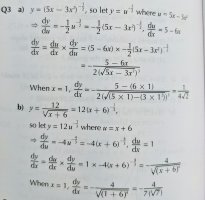I have here two examples of differentiation using the chain rule. They are both very similar except the end order of operations of the exponents and I'm very confused as to why.
f(x)=(5x-3x^2)^-1/2
f'(x)=(5-6x)/2(√(5x-3x^2))^3
f(x)=12(x+6)^-1/3
f'(x)=-4/^3√(1+6)^4
^3√ = ^-1/3 I wasn't sure how to write that properly.
In the top one we calculate the root first and then the power but the bottom one we do it the other way round and I can't see why. My understanding is that we always calculate the root first and then do the power?
I've tried to be clear but I may have fluffed it. Apologies if I've made a mistake. I have attached the workbook answers as a picture as well.
Thanks
f(x)=(5x-3x^2)^-1/2
f'(x)=(5-6x)/2(√(5x-3x^2))^3
f(x)=12(x+6)^-1/3
f'(x)=-4/^3√(1+6)^4
^3√ = ^-1/3 I wasn't sure how to write that properly.
In the top one we calculate the root first and then the power but the bottom one we do it the other way round and I can't see why. My understanding is that we always calculate the root first and then do the power?
I've tried to be clear but I may have fluffed it. Apologies if I've made a mistake. I have attached the workbook answers as a picture as well.
Thanks

